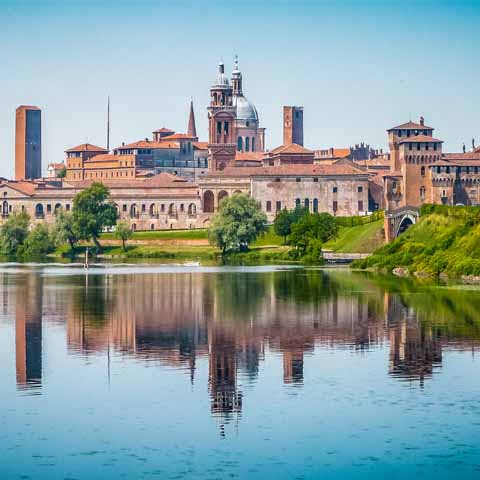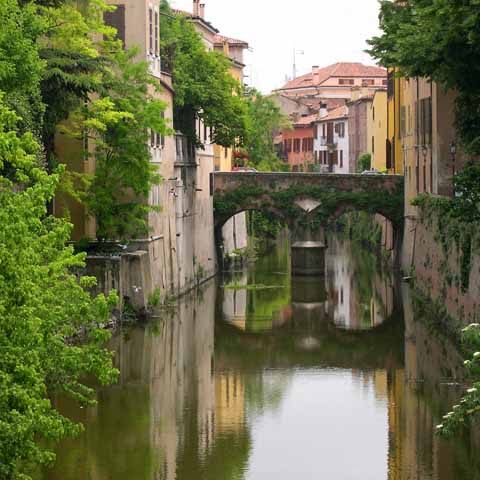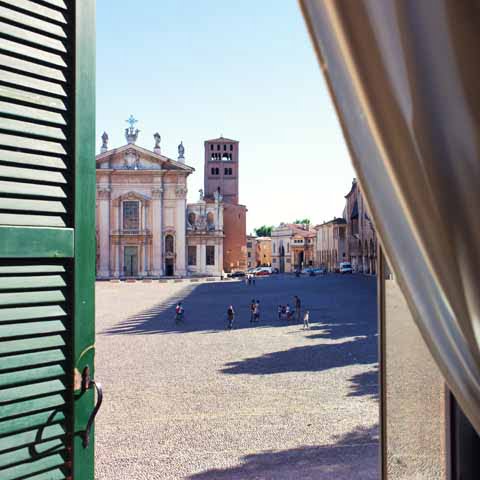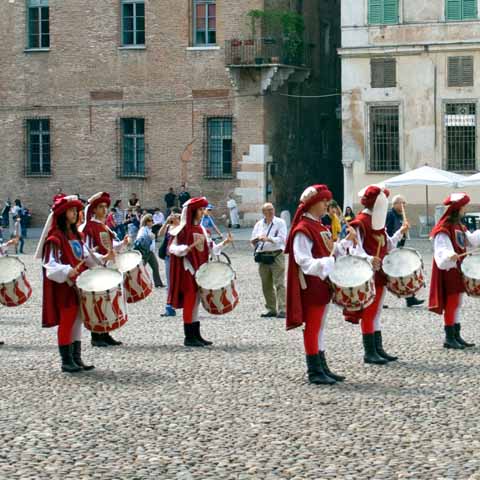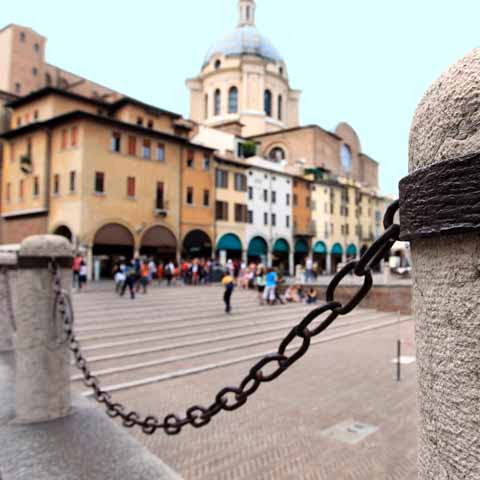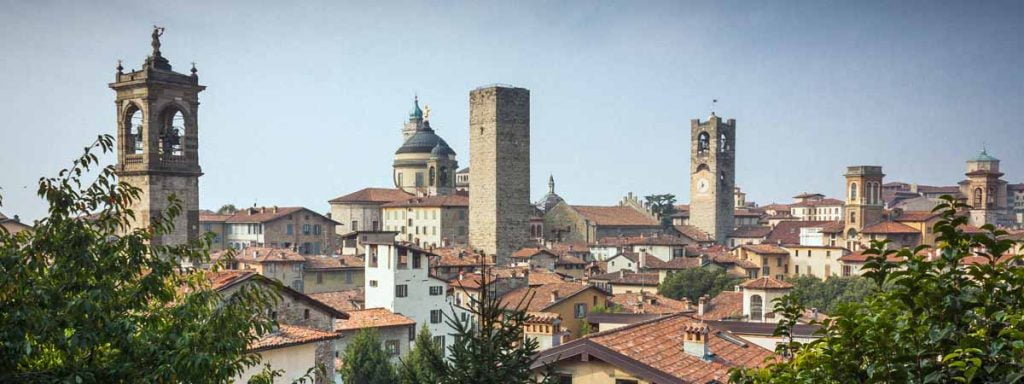If there is one thing that Mantua is best known for – it is culture. For centuries, Mantua has been a heralded destination for art lovers, architectural fans, musicians, culinary connoisseurs, and artists of all types. In fact, Mantua was distinguished as the Italian Capital of Culture in 2016. It was the first city to be awarded this honor. In 2017, Eastern Lombardy, including Mantua, was designated as the European Region of Gastronomy for that year. And, together with the nearby city of Sabbioneta, Mantua’s centro storico (historic center) was dubbed a UNESCO World Heritage Site in 2006.
Mantua, a city often referred to as a jewel of the Renaissance, gained this identity as a cultural hub far back in its history. When the Gonzaga family ruled Mantua during the city’s glory days, the arts were considered a top priority. The family highly valued culture and artforms of all kinds, so those aspects of life were protected and celebrated. The House of Gonzaga was known for hosting famous artists, talented architects, literary masters, and musical geniuses. Some of these famous guests included Donatello, Leon Battista Alberti, Giulio Romano, Torquato Tasso, Andrea Mantegna, Domenico Fetti, and many more.
The Gonzaga family’s prioritization of arts and culture established Mantua as a top cultural destination early in the city’s history, earning it the reputation as a top cultural hub of Italy.
Today, the city is well known for its stunning architectural masterpieces – specifically its incredible palaces, vast collections of artifacts and works of art, unique cuisine, and its city-wide culture, which is deeply rooted in the appreciation for all things related to art and beauty.
ART IN MANTUA
The Gonzaga family’s love of fine art is what gave Mantua the artistic spirit that the city is associated with today. During the family’s rule from the 1300s to the 1700s, the city was decorated by famous artists from around the world. The Gonzaga collected countless works of art and commissioned artists such as Caravaggio, Raphael, Correggio, Mantegna, and many more to paint frescoes in their churches and palaces.
For travelers hoping to experience art in Mantua, simply walk through any one of the city’s sprawling palaces or important churches. The walls and ceilings of Mantua’s palazzi and important spiritual buildings make these structures art museums within themselves.
Among the most notable examples of art found in the city are the breathtaking frescoes by Andrea Mantegna found in the Camera degli Sposi. Located in the expansive Palazzo Ducale, the walls and ceiling of this room are covered with rich decorations and intricate frescoes commissioned by Ludovico III Gonzaga, ruler of Mantua at the time. The frescoes depict a Gonzaga family portrait as well as important scenes from the life of Ludovico. The frescoes are also renowned for Mantegna’s use of trompe-l’œil.
Another great place to admire art in Mantua is the Palazzo d’Arco. This Neoclassical palace features works by Bernardino Luini, Anthony van Dyck, and others in its art gallery.
ARCHITECTURE IN MANTUA ITALY
A stroll through the city will reveal the architectural importance that Mantua holds. The city’s Renaissance architecture and important ecclesiastical buildings serve as reminders of Mantua’s past.
Like art, the Gonzaga family valued and prioritized great architecture, often commissioning famous architects to design and build structures for them. As a result, most of the city’s great architectural sites are from the period during the rule of the Gonzagas.
Mantua is home to incredible palaces, each of which is a testament to Italy’s incredible architecture and home to historic artwork.
These palaces include Palazzo Ducale – the famed, mammoth sized Gonzaga family palace complete with 500 rooms, Palazzo Te – the palace that was built as an escape for Federico Gonzaga and his mistress, Palazzo Vescovile and Palazzo Rivabene – the former is the current residence of the bishop, while the latter is a fifteenth century construction that houses frescoes by Giuseppe Bazzani and Louis Dorigny.
The city is also home to many churches, which are evident of the area’s spiritual history. Top sites include the Basilica of Sant’Andrea (with an impressive dome designed by famed architect Filippo Juvarra), the fourteenth/fifteenth century Duomo built in the Romanesque style with Gothic elements, the ancient Rotonda of San Lorenzo, and the sixteenth century Church of San Sebastiano.
Of these buildings, the Rotonda of San Lorenzo is particularly interesting from an architectural perspective. The brick construction dates back to the sixth and seventh centuries and is renowned for its unique rounded shape. The current site of the Rotonda is believed to have once housed a Roman temple dedicated to Venus.
LITERATURE FROM MANTUA
One of Mantua’s most exciting events for fans of literature is the annual literature festival called Festivaletteratura, which is one of Italy’s most important literary events. Held annually since 1996 every September, the International Festival of Literature is a place where writers and readers gather together to celebrate the written word.
Mantua’s connection with literature spans far back in its history. In fact, Shakespeare used the city as the location for Romeo’s banishment in his iconic play “Romeo and Juliet.” And the famed Roman poet Virgil was born near the city of Mantua. Travelers can see a statue commemorating him in Piazza Virgiliana.
MUSIC
When the Gonzaga family ruled Mantua, various famous composers were employed by the court, creating the start of the city’s love affair with music. Vincenzo Gonzaga employed the composer Claudio Monteverdi during the time in which he wrote the Vespers of 1610. Antonio Vivaldi was also employed by the governor of Mantua in the early 1700’s. It is said that the city inspired him to write the Four Seasons.
Mantua is also well known for its significant history in the world of opera. Monteverdi premiered his opera L’Orfeo in Mantua, which is considered to be the oldest opera still regularly performed, and Giuseppe Verdi’s opera Rigoletto is actually set in Mantua. Medieval buildings and the foggy weather served as inspiration for Verdi when writing the opera. Mantua has also attracted some of the world’s most renowned opera singers, such as Luciano Pavarotti, to study and improve their craft in the city. Travelers can also take in an opera at the famed Teatro Bibiena – home to the Mantova Chamber Orchestra. The theater was inaugurated by none other than young Wolfgang Amadeus Mozart and his father Leopold while the pair were in Italy during Mozart’s first tour of the country.
There is also a history of violin making in Mantua. Famous violin makers Stefano Scarampella and Pietro Giovanni Guarneri both lived in Mantua and established themselves in the city.
For lovers of music looking to enjoy local events in Mantua, there is an annual jazz festival held in the city every July as well as an annual event at Teatro Bibiena called the Mantova Chamber Music Festival.
CINEMA
While Mantua is not yet recognized internationally as a filming location, the beauty and history of this city has been featured in several Italian films and TV shows. Movies filmed in Mantua include: Senso (1954), La marcia su Roma (1962), Strategia del ragno (1970), Novecento (1976), Don Camillo (1983), Il portaborse (1991), and Sandrine nella pioggia (2012).
SCIENCE
Along the shores of Lake Mezzo, lives the Parco della Scienza, or Science Park. The name of the park derives from interactive scientific installations designed by Raffaello and Tobia Repossi found throughout the grounds. The installations encourage visitors both young and old to learn about echoes, optics, energy, and more.
The city of Mantua may not be as famous as some of Italy’s other cultural heavyweights, yet the vast wealth of art and architecture amassed during the nearly 400-year rule of the Gonzaga family makes this gem more than worth a visit. Travelers seeking to enjoy Italy’s culture will not be disappointed by a stop in this eminent Northern Italian city.
Don't just see Italy, live it.
Your dream trip to Italy has never been closer
No more endlessly scrolling travel sites. Our travel experts will craft the perfect, one-of-a-kind trip just for you.

300+
DESTINATIONS
We offer more Italian destinations than any travel site. Do and see more with Trips 2 Italy.
1 (of a kind)
ITINERARIES
Because your dream trip to Italy should be designed for you, not for the masses.
100%
PEACE OF MIND
From flights and accommodations, to food and activities - we take care of every detail.
